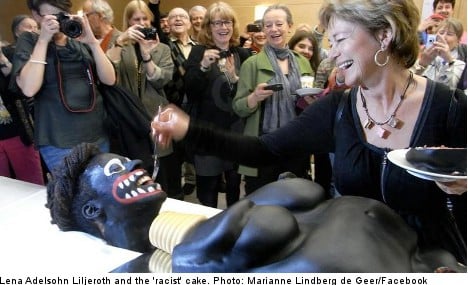The art performance “Painful Cake” by the Afro-Swedish artist Makode Linde, staged at the Moderna Museet in Stockholm, has received a strong reaction from the Afro-Swedish community due to the installation’s racist content.
The cake consisted of a disproportionate female body with large breasts and vagina coupled with tiny limbs, while the artist himself acted as the head of this monstrous creation, painted as a crude minstrel caricature.
The Swedish minister of culture was encouraged to cut the cake and she chose to cut at the point of the vagina, which she then fed to the artist to the applauds and laughter of the audience.
The artist claims this to be an antiracist performance and explains that the cake was supposed to symbolize the mass graves, cutting and female genital mutilation. The organizers of the event and the minister have since argued that art has the right to provoke.
However, we must ask ourselves what relations of power this “provocation” builds on, if those left with the feeling of exploitation and exposure – and thus also those most offended by the performance – are also those this creation of art claims to liberate: namely black women.
Our argument is that when exploring any social phenomena impacting black women, one cannot be restricted to a solely racial analysis, or an interpretation strictly based on gender.
Rather, any analysis of black women must also include an examination of their historical relationship with racial, gender; economic, and sexual oppression.
The performance in which the minister participated literally re-created a gendered racist stereotype in the shape of a disfigured black female body with huge genitalia and breasts, naked and on display for the white audience.
Furthermore, the audience was then encouraged to participate in the genital mutilation of this body, while accompanied by shrieks of pain from the artist.
If the political message intended by the artist was to make the white audience feel uncomfortable when cutting into the cake, thus prompting them to reflect about racist stereotypes, then it’s not at all clear why he had to use an existing racist cultural frame of reference that depicts black women as unsightly, deformed and diseased.
The consequence is that the only ones engaged in conversation with the artist are the members of the white audience.
And he does not speak for, or to, the audience of black women through his work of art.
This abuse of the naked black female body completely disregards black women’s integrity and political interests. The consequence of this is that the intended message of the performance is only meant for the white audience, thus cutting off any possible connection with the untold stories of black women and their existence in oppressive structures of society.
The only conclusion that can be drawn is that the performance is masked by claims that it is anti-racist; claims which ultimately ring hollow and designed to fail.
The images like those from the installation simply objectify the mistreated and mutilated black female body and in so doing strip black women of their basic humanity.
They also tacitly condone the objectification of the black female body by others, thus maintaining black women’s servitude in the eyes of those who view her.
The roots of some of these objectifying images can be traced back to stories of Sara Baartman, the so-called Hottentott Venus, whose body was exploited and exhibited in freak shows for the delectation of a middle-class white audience in Europe at the beginning of the nineteenth-century.
Whatever the political critique may have been intended by the performance, the effect seems to be that the audience, laughing uneasily, becomes complicit in supporting acts that continuously victimize black women within structures rooted in systematic racial voyeurism, gender mutilation and cannibalism.
In this respect the actions committed by the minister of culture, the artist, and the white audience simply feed into a well-established pattern of overt stereotypes that persist about blacks and other people of colour that serve to marginalize certain populations.
The ‘Painful Cake’ incident is thus yet another sharp reminder of the urgent need for the piecing back together of black women and uniting in the struggle for both gender and racial equality.
These controlling images, brought once again to the fore by the art installation, are designed to make racism, sexism, poverty, and other forms of social injustice appear to be natural, normal, and inevitable parts of everyday life.
It is resistance to these controlling images that will eventually change the inevitable, and bring black women further away from oppression.
Victoria Kawesa, PhD candidate in gender studies, Linköping University
Viktorija Kalonaityte, Senior Lecturer, Linnaeus University
Ellen Belmore, Graduate in Gender Studies, Uppsala University



 Please whitelist us to continue reading.
Please whitelist us to continue reading.
Member comments